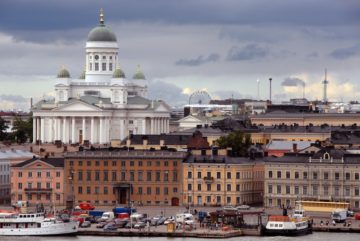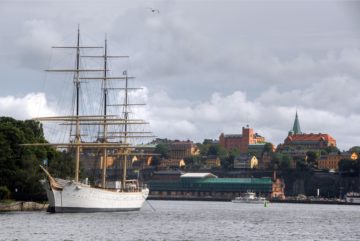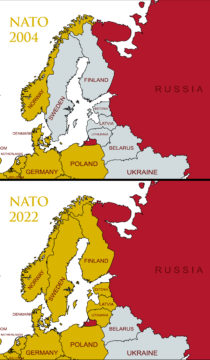by Bill Murray

I
Russia’s war on Ukraine is realigning geopolitics everywhere you look. The Germans and French want the conflict to end immediately. Others won’t be heartbroken to see fighting continue to degrade Russian capabilities. The UK, Poles and Balts come to mind here. An idea is settling in that the US, too, doesn’t entirely mind fighting Russia to the last Ukrainian. There’s no denying the war is less painful from forty five hundred miles away.
Look north and if Finland and Sweden join NATO, overnight the Baltic Sea becomes the beating heart of European security. The shallow, enclosed Baltic hasn’t played such a heady role since the days of Napoleon. Vilnius and Riga never dreamed of such proximity to power.
In 2019 Mikhail Saakashvili, a previous victim of Russian aggression, predicted Russia’s next attack would come against Finland or Sweden. He was wrong, but he might not be wrong forever. That’s the fear that fuels an astonishing rush toward strategic realignment around the Baltic Sea.
Finnish President Sauli Niinistö is two years shy of wrapping up his second six year term. The 73 year old son of a newspaperman and a nurse from Finland’s southwest coast, Niinistö consistently polls as the country’s most revered figure.
He was in Washington a week and a day after the Russian invasion of Ukraine, already working to insure the American administration’s blessing for Finland’s accession to NATO. The Finns hold their president in such regard that his backing of Finland’s coming NATO application should insure the peoples’ approval.
Niinistö put it this way: “Sufficient security is where Finns can feel that there is no emergency and there won’t be one.” Joining NATO, he said, would be “most sufficient.”
Finland comprises a small, homogenous, linguistically unique space of five and a half million people. Its ethnicity is only recently beginning to be diluted, and not without incident, by the humanitarian welcome of mostly Arab and Somali refugees. Finns have a healthy self regard, a certain satisfaction with the place in the world they’ve staked out for themselves and how they’ve done it. A local word, sisu, sums up their perceived self-sufficiency, perseverance and grit.
Opinion there has taken a remarkable, historic and loudly proclaimed turn during the war on Ukraine. Support for joining the NATO alliance stood at a historically consistent 24 percent as recently as four months ago. After the period of “Finlandization,” a pejorative term for Finns, at the end of the Cold War they reckoned they’d worked out a modus vivendi with Russia and saw no need to upset the balance by joining a military alliance. Until now. Two months after Russia’s invasion of Ukraine, support for joining NATO polls at a historic 68 percent.
Neither Russia’s 2008 invasion of Georgia, which caused the fall of Saakashvili, nor Russia’s 2014 annexation of Crimea moved Finnish public support for Nato membership out of the twenties. In the 2015 Finnish parliamentary elections, 91% of Social Democrat candidates were opposed to Nato membership.
In January this year, before the invasion of Ukraine, Finnish Prime Minister Sanna Marin, age 36, former city councilwoman, bakery worker and cashier in Finland’s second city of Tampere, judged it “very unlikely” that Finland would apply for a NATO membership during her current term. As it turns out, when she and her Social Democrats defend their coalition government in parliamentary elections next April, they all hope Finland will already be a NATO member. She explains the switch by declaring, “Russia is not the neighbor we thought it was.”
“All of a sudden, it seems the Finnish population have decided: there is only one option. It’s a radical change, a huge shift in momentum,” said Charly Salonius-Pasternak, lead researcher at the Finnish Institute of International Affairs. It now appears the Finns have convinced themselves that some version of their 1939 Winter War against Russia could happen again.

It is a fateful decision, and not just for the Finns. Finland and its Swedish neighbor have historically made a show of binding their policies about NATO. The Swedes proclaim it explicitly on their government website: “Sweden’s most far-reaching defence cooperation is its cooperation with Finland. The two countries have similar security policies, and they both wish to expand their already extensive defence cooperation.”
Finland is carrying Sweden’s water here. It has always been understood any decision about NATO would be taken together. While Swedish public support for NATO has always run ahead of the level in Finland, the Swedish Social Democrats have traditionally been opposed, and they head the current governing coalition.
In a statement Swedish Prime Minister Magdalena Andersson said “Sweden has not witnessed the same spike in public support, despite traditionally having more public support for NATO than Finland.”
“I do not rule out NATO membership in any way, but I want to make a well-founded analysis of the possibilities open to us and the threats and risks… involved, to be able to take the decision that is best for Sweden.”
Her party held a six-hour meeting in Stockholm on Friday to begin deliberations on whether to change its position. A poll conducted last week by the newspaper Aftonbladet, which is close to the party, showed Swedish support for NATO at 57 percent. Most importantly, parliamentary elections are less than five months away.
Sweden hasn’t been openly at war with another country since the days of Napoleon, and today’s map is straightforward. Since Sweden has no Russian border, joining NATO ought to be easier for the Swedes than for the Finns. Because the Finns have jumped out front, Elizabeth Braw says Sweden has won the NATO lottery.
II
Americans are pretty proud of our opinions, and being Americans, we expect them to matter a whole lot. Trouble is, U.S. opinion reflects very little of the lived experience of the 65 million people living in the seven countries around the Baltic excluding Germany and Russia.
Here in the United States our idea of freedom, our brashness and swagger and gun culture and concealed carry laws and disdain for those who would protect us with masks, they’re not quite the same idea of freedom our frontline European allies have in this war. Here, freedom comes with standing with a gun and proclaiming it. There, freedom comes from standing with a gun and meaning it.
Where we make noise with fireworks on July 4th, to celebrate Finland’s freedom from Russia every December 6th Finns light candles in their windows. In December it’s dark by 3:30.
In contrast to the rambunctious American version of freedom, Matt Dinan describes a northern view, a view that also prevails in Nordic winter: “In Canada or the snowier parts of New England and the Midwest, winter travel always bears an implied asterisk. This small but meaningful restriction of freedom puts the lie to the dream of unbounded freedom or autonomy.”
Well meaning Americans like that “dream of unbounded freedom,” sort of an unlimited, abstract, all-you-can-eat freedom, but that’s not quite the type of freedom the Baltic nations are after. They want freedom from the very real threat of invasion.

And so in the coming days Finnish Prime Minister Marin will set Finland’s formal NATO application process in motion. On April 15th Foreign Minister Pekka Haavisto (Green) told state broadcaster YLE that “if Finland is going to submit an application for membership, it will happen in the next six weeks.” That means by the end of May.
The Finnish constitution endows the presidency with the foreign affairs portfolio. In President Niinistö’s shuttling between NATO capitals he will be asking for swift accession, hoping to forestall Russian belligerence in the interregnum between acceptance of Finland’s application and attainment of Article 5 protection.
How fast can they get it done? There’s no exact precedent, but Montenegro took about 18 months in 2017/2018, North Macedonia took 14 months in 2020 and Croatia and Albania, who joined together in 2009, took twelve.
None of these cases are entirely analogous to Finland’s prospective membership; Finland “boasts a higher degree of interoperability with NATO allies and a longer track record of partnership. Given the current exceptional situation, the process could be remarkably quick.”
Until it is done, Finnish political leadership is trying to inoculate the public against inevitable Russian sabre rattling. Dmitri Medvedev declared that “There can be no more talk of any nuclear–free status for the Baltic – the balance must be restored.”
Finnish Foreign Minister Haavisto was dismissive. “Russia’s position on Finland and Sweden joining NATO has been common knowledge for a long time, and the reaction is therefore predictable and expected,” he said.
Besides, that really is all just so much bluster inasmuch as nuclear weapons have resided in Kaliningrad for at least several years. And Finland’s Santa Claus village near the Arctic Circle at Rovaniemi, which welcomes around half a million tourists each year, is something like 250 air miles away from the Gadzhiyevo naval base on the Kola Peninsula, “likely Russia’s most important location for naval strategic nuclear forces.”
The Foreign Minister’s “nothing to see here folks” stance doesn’t entirely calm the conspiracy-minded Nordic heart, though. Unsettling things do happen. Stories abound in communities in Finnish Karelia and Savo, near Russia, about suspicious Russian land purchases and general perfidy. The Carnegie Endowment has a list: “Mock attacks by Russian bombers in the middle of the night. Mysterious mini-submarines appearing in the waters outside Stockholm. A small private island in the southern Gulf of Bothnia bristling with satellite antennae and a heliport.”
III
Finland punches above its weight in part because it’s a small country with a largely homogenous population (like Sweden), that can act with more solidarity that a fractious, larger US or, say, France. This plays to its advantage in times of stress. It also has a certain national pride. It thinks it’s done pretty well as a small country unavoidably adjacent to a stifling giant.
Finland will be unique from other Russia-facing NATO forces. It has demonstrated performance as a cohesive defensive force, it has no legacy of aging former Warsaw Bloc equipment and no legacy of former Soviet training.
The three Baltic NATO members and the former Warsaw Pact NATO countries are all undermilitarized for a real conflict and rely on symbolic US forces as tripwires. For example, through a rotating NATO group called Atlantic Resolve, before the Russian invasion of Ukraine there were 1867 American troops in Poland, 1134 in Romania, 77 in Hungary, 55 in Estonia, 22 in Bulgaria, 18 in Lithuania, 15 in Czechia, 14 in Latvia and 12 in Slovakia.
Compare that to “The Warsaw Pact’s more than 3 million troops — most of them Soviet — [who] never fought their Cold War NATO adversaries, and the chief action they saw was in crushing popular anti-Communist movements inside member countries” as the Washington Post put it in a 1990 article marking the Warsaw Pact’s dissolution.
We came to see the state of those Soviet troops as underfunded and desperate. As Warsaw pact troops pulled out, M. E. Sarotte writes that “Soviet forces smashed barracks, ripped out telephone lines, set off unannounced explosions, and left an environmental ‘mess’ including leaking oil barrels. They also started selling their weaponry, ‘including tanks,’ on the black market.” Such was the state of play from which Hungary, Poland, Czechoslovakia and Romania were left to build their own sovereign defenses.
In the soon to be Baltic republics of Estonia, Latvia and Lithuania the task was more grim. I remember personally the head-shaking disgust with which newly sovereign Estonians described how retreating Russian soldiers pulled out and ran off with all the wiring in their barracks, to sell the copper at home.
From those desperate beginnings these impoverished newly independent states had to stand up their own armies, none of which have ever had to defend their countries against an assault, in contrast to the state of high readiness in Finland today.
For all that, there still comes the military question whether all NATO member governments would be keen to introduce 833 miles of new Russian border to the alliance. One argument is that “Unlike many NATO allies … Finland did not significantly reduce its emphasis on territorial defense in favor of expeditionary capabilities abroad.” Finland says it’s ready.
Viewed from some remove, it’s a bold and admirable thing that Finnish politicians are doing, audacious given their unique place in history, casting their lot loudly and publicly with democracy at no small physical risk to themselves and their people. That it is courageous there is no doubt. Whether it’s a profound mistake has yet to be seen.
 Let us reflect on what Vladimir Putin has done with his invasion of Ukraine. With a future accession of Finland and Sweden to NATO, he will have caused an expansion of the alliance by 300,000 square miles (an area almost twice the size of California) on 833 miles of his border. NATO will add 280,000 Finnish soldiers, Finnish artillery (the biggest artillery force in Europe), 200 Swedish jet fighters, 65 from Finland, and the Baltic Sea will become NATO’s inland sea. Says the Guardian, “by Nato’s Madrid summit in June, Nato will be on course to expand its population by 16 million, its GDP by €800bn and its land mass by 780,000 sq km.”
Let us reflect on what Vladimir Putin has done with his invasion of Ukraine. With a future accession of Finland and Sweden to NATO, he will have caused an expansion of the alliance by 300,000 square miles (an area almost twice the size of California) on 833 miles of his border. NATO will add 280,000 Finnish soldiers, Finnish artillery (the biggest artillery force in Europe), 200 Swedish jet fighters, 65 from Finland, and the Baltic Sea will become NATO’s inland sea. Says the Guardian, “by Nato’s Madrid summit in June, Nato will be on course to expand its population by 16 million, its GDP by €800bn and its land mass by 780,000 sq km.”
Putin’s actions have motivated interested parties he can’t control, whose own actions are already busy reshaping European security. Without solving the question of whether NATO is part to blame or whether Russia has brought all this on itself, we can be sure that the resulting sanctions, boycotts and the European decision to wean itself from Russian energy will wound Russia deeply. Here may be a more critical long term worry, peril from the wounded and howling giant. In time, who created a paranoid nuclear state may become less important than what to do about it.
